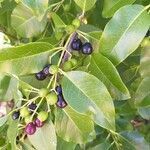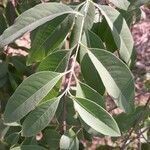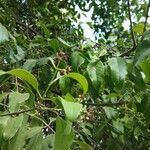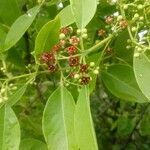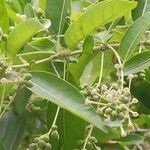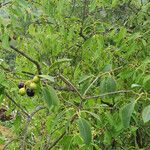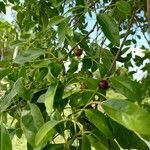Shrub, sometimes scandent, to 3.3 m. Branchlets slightly angular-striate. Leaves ovate, sometimes broadly lanceolate-elliptic, obtuse or acute, slightly discolorous, light green; lamina mostly 2.5-7 cm long and 1.5-4 cm wide; reticulate venation evident; margins flat or slightly recurved; petiole 2-ribbed, 5-15 mm long. Flowers up to 6 in small terminal and axillary panicles or umbels; peduncle 4-11 mm long; pedicels less than 1 mm long. Receptacle 2 mm long. Tepals triangular to ovate, obtuse, c. 2 mm long, red or green; hair tufts long, coarse. Disc with prominent, ovate lobes. Style 2 mm long; stigma 3-lobed. Drupe ±sessile, ellipsoidal, 7-8 mm long, with small apical collar; epicarp dark red to black; endocarp smooth.
A shrub or small tree. It grows to 3 m high. The leaves are opposite and smooth. They are oval and 2.5-7 cm long by 1.5-4 cm wide. They are light green above and paler underneath. The stalk is about 1 cm long and has a groove. The flowers are small and red or green. They are about 0.5 cm long. The fruit are smooth and round. They are fleshy with a stone inside. The fruit are 0.7-1 cm across. They are shiny red to black when ripe. There is a single seed inside. It normally feeds on the roots of nearby plants for some of its nutrients. It cannot grow on the roots of the Mango family.
Evergreen shrub or small tree.. Leaves opposite, petiolate, often glaucous beneath, elliptic to ovate-elliptic, 4–9 x 1.5–3.5 cm, pinnately nerved.. Flowers in thyrses, 1–3 per bract.. Perianth pale green turning purplish inside, the lobes 4(–5), 2 mm long, bearing a small stamen in a tuft of hairs.. Fruit a drupe, reddish purple turning black, subglobose, 1–1.5 cm diameter.
